Latest news about Bitcoin and all cryptocurrencies. Your daily crypto news habit.
Analytics platforms tend to evolve the way businesses do. As the business gains maturity, the tools tend to change, and that’s ok; different platforms serve different purposes.
We typically see 3 distinct phases of analytics:
- The Good Enough phase: Early on, businesses might not have enough customer data to make decisions based on analytics. There may or may not be someone actively looking at the data, and because implementing analytics often competes with other core activities — like shipping a product — analytics are often set and forgot. For the good enough phase, analytics platforms have to be really quick to implement.
- The Head Above Water phase: Once the business is able to get its head above the water, investing in analytics (and an analytics team) makes a lot of sense. Analytics can help better define and understand the business model. Because the business challenges are clearer at this point, it becomes easier to find the right tool for the job. During this phase, it’s often more important for the data to point in the right direction, than to be entirely accurate.
- The Accuracy phase: Because of outside pressures (read: investors) or the desire to scale customer acquisition with realiable data points, analytics eventually have to become 100% accurate. To reach that level, businesses often invest in robust backend analytics or their own data warehouse. The analytics platforms may remain the same, but often business intelligence platforms like Tableau, Domo and Looker are introduced.
One of the best things about Highlights, is that we’re at the intersection of data and email marketing. Because we’re not an analytics or a marketing automation platform, we’re in a good position to objectively assess the value of the different platforms.
To help you find the best analytics platform for your business, we created the following list comparing the main options available today. Here goes:
Google Analytics
With more than 50 million website setups, Google Analytics (GA) is the most popular analytics platform. It’s free (up to 10 million hits per month), easy to setup, and it can be very powerful once Goals, Events and Ecommerce revenue are setup.
GA seamlessly integrates with other Google products like AdWords, the Search Console and Google Data Studio. Out of the box, it provides insights on the performance of your web and landing pages, acquisition channels and paid acquisition. It’s a very complete platform, but rather cumbersome.
As your business grows, some of the functionalities, data sampling, data refresh rates, and the lack of people analytics (it’s not allowed in Google Analytics) may start to feel limiting.
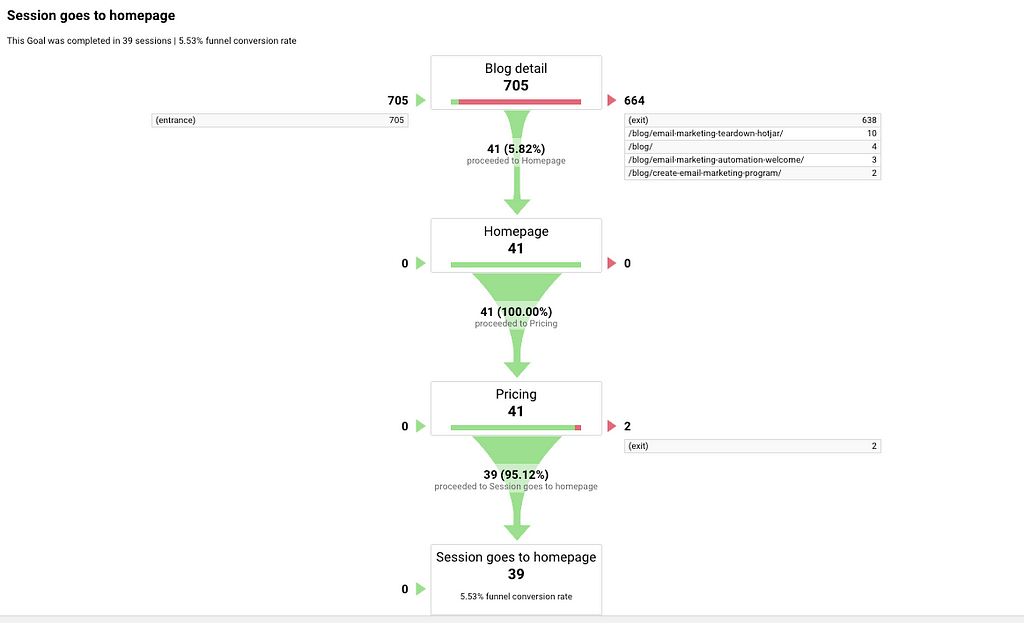 Google Analytics — FunnelsWhen Google Analytics is the Right Analytics Platform
Google Analytics — FunnelsWhen Google Analytics is the Right Analytics Platform
- Most marketers and product managers have some level of familiarity with GA. If your team is already comfortable with the platform, it’s a good idea to use it.
- GA can be set up in minutes and won’t impact the performance of your site. It’s a good option to centralize data and track historical performance before you have the bandwith to dig deeper into it.
- It has powerful features for content and E-commerce websites (revenue tracking, goals, behavior flows, etc). Depending on the complexity of your business and how far you want to push it, it might be enough.
- If Search and/or AdWords are important acquisition channels for your business, you’ll need to use GA to get richer insights (it’s actually mandatory 😉).
Mixpanel
Mixpanel is an event-based analytics platform. This means that, unlike with Google Analytics, you need to define the actions and events (e.g. Signup, Purchase, etc) sent by your app or website. Once configured, you’ll be able to use Mixpanel’s user analytics, create funnels, analyze retention cohorts and flesh out user journeys.
Mixpanel is more than an analytics platform. It can be used to send emails, SMS messages, push notifications, and in-app messages to customers based on their profile and what they’re doing in your product. Mixpanel also has a really interesting approach to mobile analytics and the capacity to run A/B tests.
Although Mixpanel’s Free plan is not as generous as Amplitude’s (below), its pricing is more flexible, and sometimes more affordable.
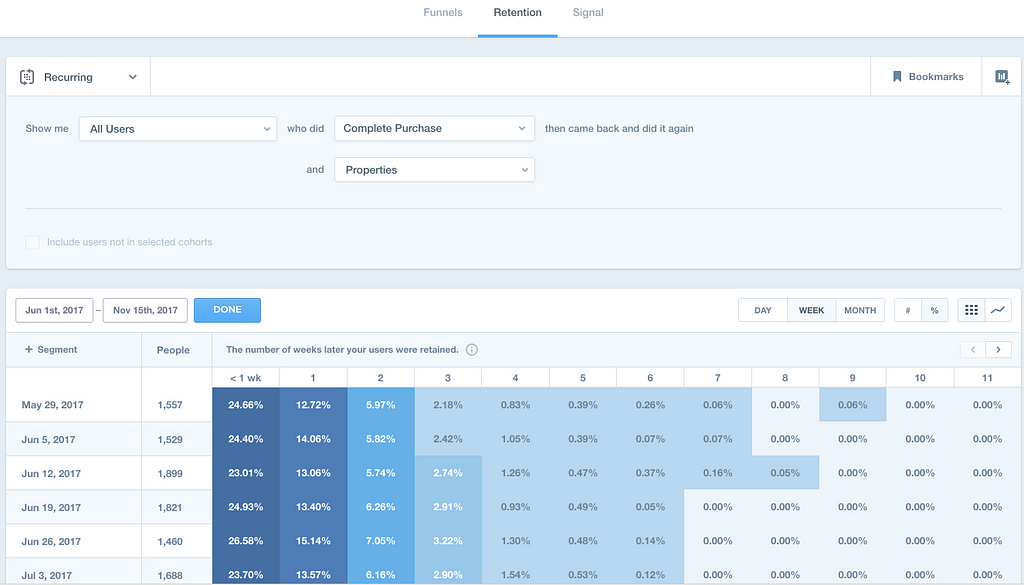 Mixpanel — Retention CohortsWhen Mixpanel is the Right Analytics Platform
Mixpanel — Retention CohortsWhen Mixpanel is the Right Analytics Platform
- Mixpanel takes a bit of time to setup, but it’s easy to use to analyze user behaviors, retention and feature adoption.
- Mixpanel’s SDK for mobile app analytics (iOS and Android) is among the best on the market. You’ll be able to get rich insights on mobile usage with their platform.
- Depending how far you want to go with marketing automation, you can use Mixpanel to send push notifications, emails, and SMS messages.
Related Post: How to Setup Google Analytics for Your SaaS App
Amplitude
Like Mixpanel, Amplitude is event-based, and will require a bit of setup in order to get started. Once setup, you’ll have access to a really powerful platform to track feature adoption, engagement and retention. Some of their core features (Compass, behavioral cohorts, etc) are designed to help you find the Aha moments — moments of realization of value — in your product.
Their Free plan is very generous with 10M actions (any event sent to Amplitude) per month, but most of their unique features like Compass, the SQL integration and the predictive analytics are locked behind a fairly expensive subscription.
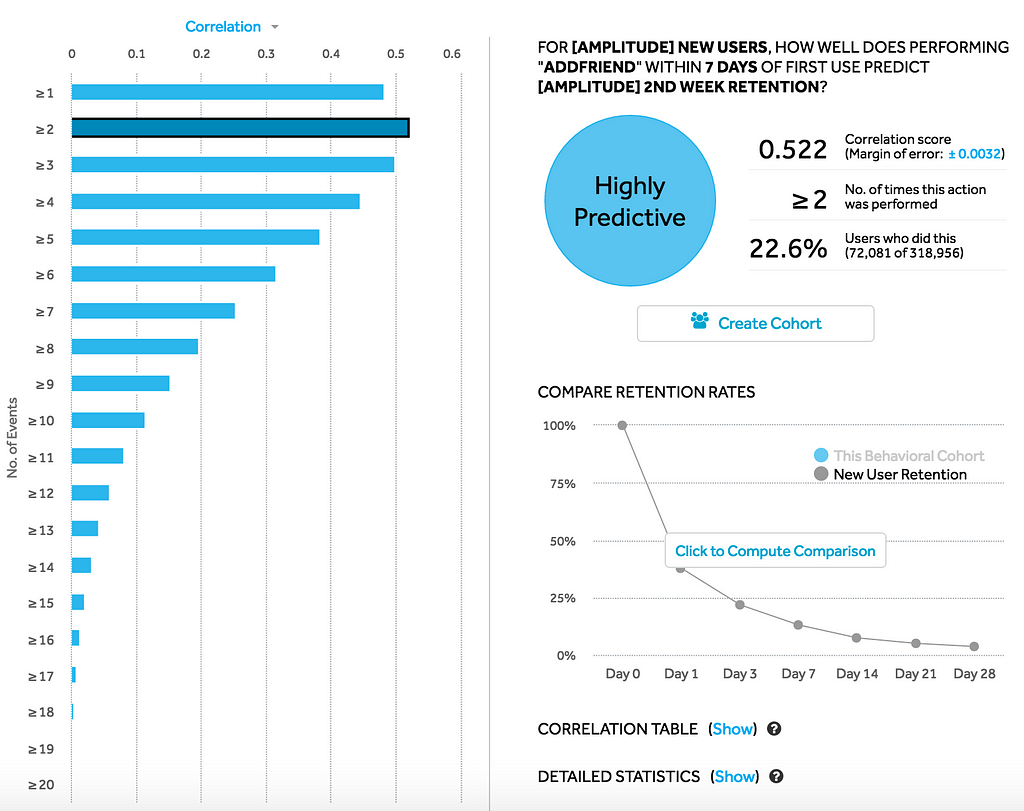 Amplitude — CompassWhen Amplitude is the Right Analytics Platform
Amplitude — CompassWhen Amplitude is the Right Analytics Platform
- Amplitude is one of the best products you can use to understand feature adoption, track funnels and understand user behaviors. We use it everyday at Highlights.
- You can use Amplitude to find your North Star metric and your product’s Aha moments.
- Amplitude was designed to facilitate sharing. Their Free plan comes with unlimited user seats, which really helps with data democratization.
- If your business has raised capital or is generating revenue, Amplitude might be a good option for the 3 phases listed above.
Heap
Heap has a different approach to analytics; it automatically captures data without the need for upfront configuration.
Within Heap, non-technical (or technical) users can create virtual events that can be used in funnels, cohorts or any other analyses. Virtual events can be changed whenever the business wants, which means that their data model is more flexible than any of the other platforms on this list.
Much like Mixpanel, Heap has a codeless mobile SDK. Their model consolidates all user data as virtual users or user profiles. The data collected by Heap can be augmented with external services like your marketing automation data or CRM data. However, their Free plan is limited and their pricing increases quickly.
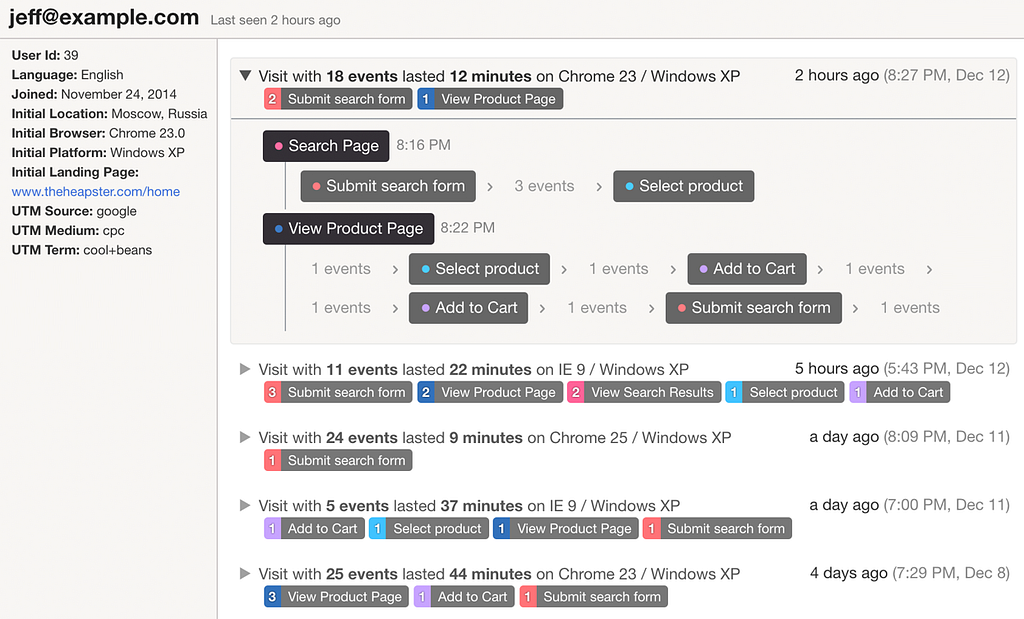 Heap Analytics — User ProfileWhen Heap is the Right Analytics Platform
Heap Analytics — User ProfileWhen Heap is the Right Analytics Platform
- A non-technical user can setup Heap. It can act as the organization’s data repository making sure that no data is lost along the way.
- If your business has raised capital or is generating revenue, Heap is a great platform to build on. You’ll be able to adapt the structure of your analytics on the fly as you see fit.
Flurry
Flurry was acquired by Yahoo!, which was in turn acquired by Verizon. It offers comprehensive mobile app analytics for all the major mobile platforms (iOS, Android, Windows, etc).
Although Amplitude, Google Analytics, Heap and Mixpanel all offer mobile app analytics, Flurry is 100% free and it’s really easy to get started fast. Flurry has great features like segmentation, push notifications and conversion funnels. Other paid platforms may have more features, but Flurry is a great option early on.
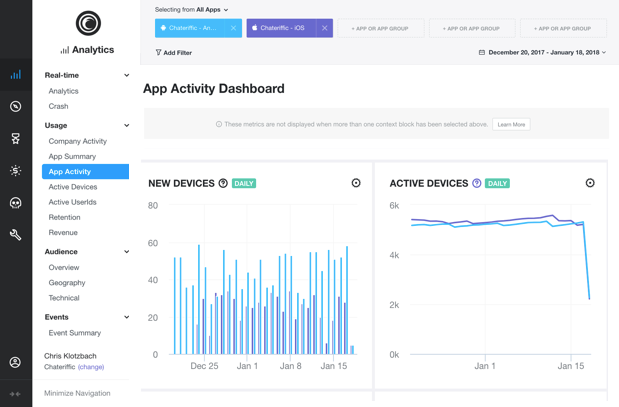 Flurry Analytics — Main InterfaceWhen Flurry is the Right Analytics Platform
Flurry Analytics — Main InterfaceWhen Flurry is the Right Analytics Platform
- Flurry is easy to use and makes it easy to get started. It keeps your cost low early on.
- It’s entirely focused on mobile, and works across platforms (e.g. iOS, Android, Windows, Apple TV, Blackberry, etc). This means that all your mobile analytics can be in one system.
- You can use Flurry for push notifications and save money.
Pendo
Pendo was originally a user guidance and communication platform. It gradually evolved into an analytics (and communication) platform. With Pendo, you can send polls/surveys, do product walkthroughs, feature announcements, and also track product engagement, funnels, user journeys and feature adoption.
Although Pendo was designed for business-to-business (B2B) organizations, it’s a good platform to connect product onboarding and analytics — something you’d need to create with the other platforms on this list. Pendo is fairly expensive, and has a limited Free plan that only allows you to send Net Promoter Score (NPS) surveys.
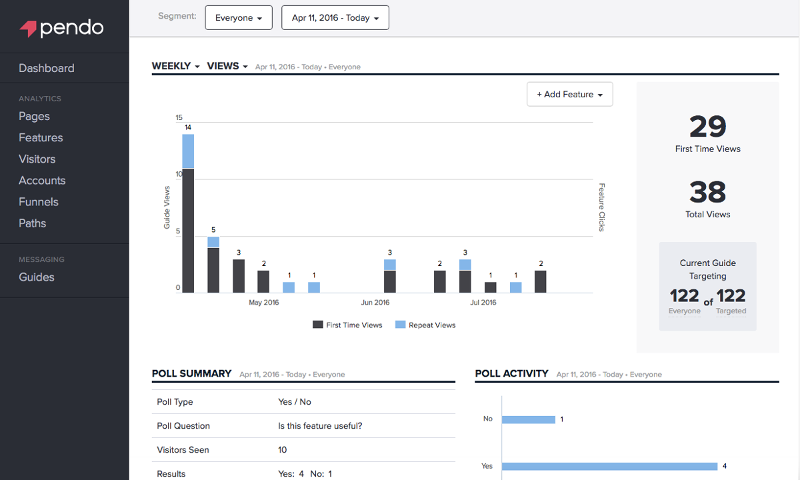 Pendo — Walkthrough AnalyticsWhen Pendo is the Right Analytics Platform
Pendo — Walkthrough AnalyticsWhen Pendo is the Right Analytics Platform
- You can use Pendo to run and analyze NPS surveys for Free.
- If your business has raised capital or is generating revenue and operates in B2B, Pendo will allow you to effortlessly connect your onboarding process with your product analytics.
Hotjar
When it comes to analytics, Hotjar is a fairly new product (2014!). Although we talked about their email program and how we use their heatmap and recording features to understand how to improve our landing page, Hotjar has a lot more functionalities.
Hotjar combines quantitative (numbers) and qualitative (feedback) data tools. Although some of the functionalities are still a bit basic, you can use heatmaps, visit recordings, conversion funnels, surveys, form analytics, polls, and recruit users for user tests. Hotjar’s Free plan tracks 2,000 pageviews per day, and their pricing scales as your traffic grows.
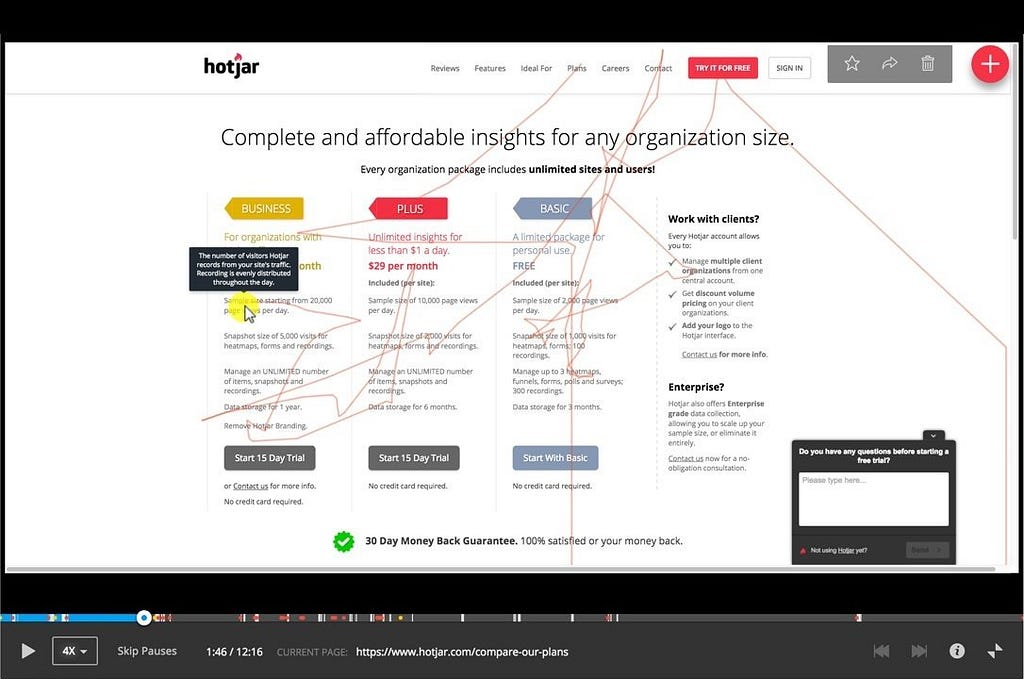 Hotjar — RecordingsWhen Hotjar is the Right Analytics Platform
Hotjar — RecordingsWhen Hotjar is the Right Analytics Platform
- Early on, Hotjar gives you access to a lot of different tools to understand and analyze your funnel and get feedback on your landing pages and website.
- With Hotjar, you can run surveys and recruit site visitors for usability tests.
- As your business grows, Hotjar gives you a toolbox to capture different types of inputs and answer different types of questions.
Crazy Egg
Crazy Egg is the original heatmap tool. It makes it possible to view clickmaps and scrollmaps for any pages on your site. It also allows you to watch recordings of user activities and compare sessions.
Non-technical users can easily turn insights into A/B tests by modifying site content directly on page. Crazy Egg integrates with Shopify and WordPress. Although there’s no Free plan (only a Free trial), their pricing is quite affordable with limits on the number of pageviews and session recordings.
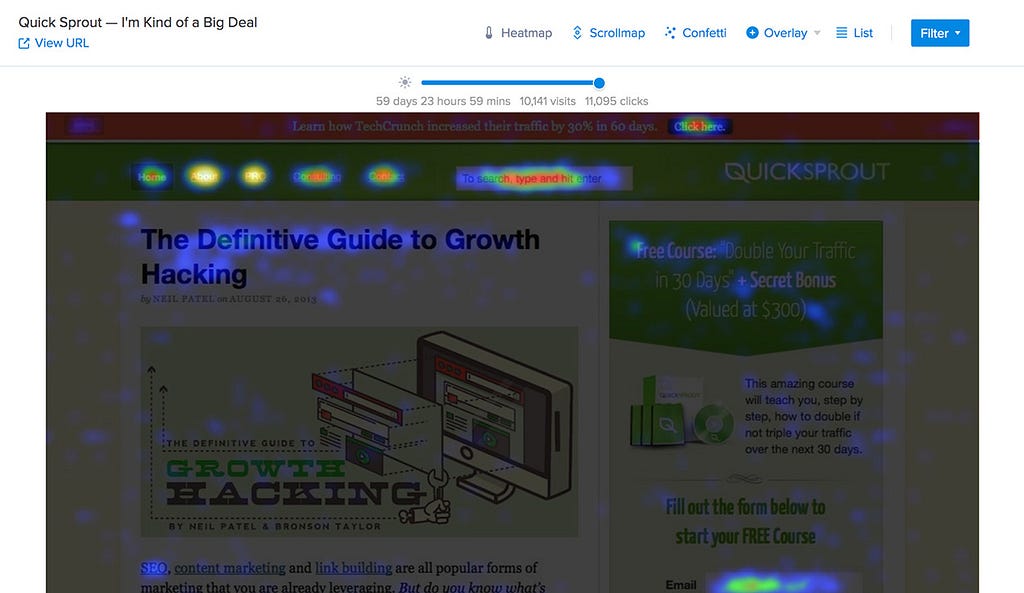 Crazyegg — HeatmapsWhen Crazy Egg is the Right Analytics Platform
Crazyegg — HeatmapsWhen Crazy Egg is the Right Analytics Platform
- When you want to quickly figure out the breakpoints in your landing pages.
- Crazy Egg will allow you to quickly run unlimited A/B tests with their simple editor.
FullStory
FullStory is more of a support and usability test platform with analytics functionalities than a pure analytics platform. It records website sessions, makes them searchable (it indexes site events and attributes) and creates a series of clickmaps (dead clicks, rage clicks, error clicks, etc) to review.
FullStory generates charts and graphs (Searchies) based on search criteria (they act like segments). Although the Free plan is fairly generous (1,000 recordings vs Hotjar’s 300), their pricing is not prohibitive. With a paid plan, you can live stream user recordings to help your team get a feel for product usage.
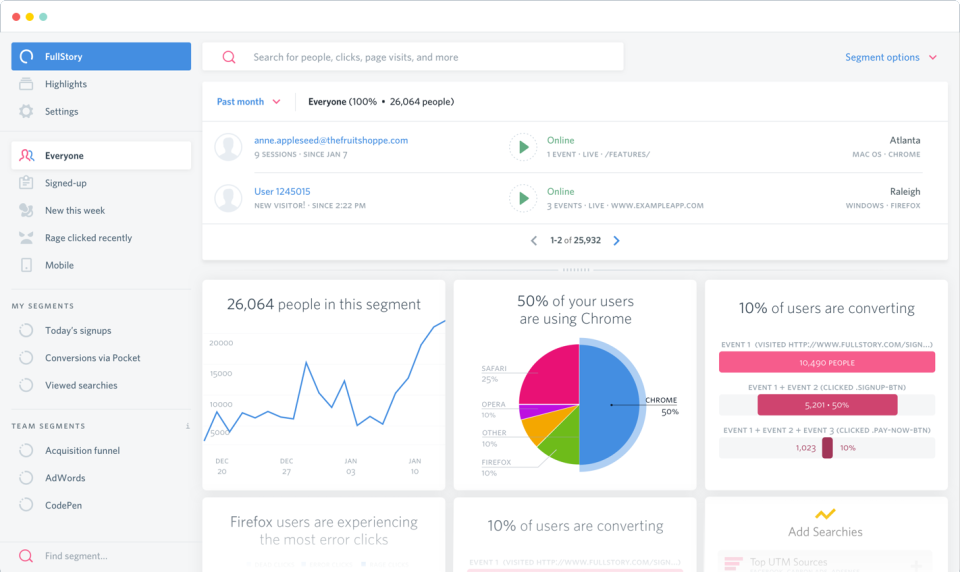 FullStory — SearchiesWhen FullStory is the Right Analytics Platform
FullStory — SearchiesWhen FullStory is the Right Analytics Platform
- FullStory will allow you to find issues with your site and landing pages. You’ll be able to identify problematic areas and dead clicks — links that never get clicked.
- On a paid plan, FullStory will allow you to replay any session for support to pinpoint issues.
- You can use it for live user testing to learn about breakpoints and issues with your site and funnels. It makes it really easy to share with your team.
How to Choose the Best Analytics Platform
There’s no such thing as a best analytics platform. To find the right analytics platform for your business, you need to first find the questions you want to answer. You can then pick the platform that best help answer those questions.
With the advent of customer data platforms like Segment, and tag management software like Google Tag Manager, it’s easier than it’s ever been to move your data from one analytics platform to another.
At an analytics meetup organized at LANDR, where Ludo and I used to work, a fellow data nerd 🤓 explained his process for finding the right analytics platform for his team:
- Find the questions the team is struggling to answer with the current platforms;
- Identify the best platforms to get those answers;
- Use Segment to send analytics data to the 3–4 best options;
- Hone in on the best platform and finalize implementation.
Analytics tools are becoming more and more specialized. There’s hundreds of smaller players that can do things larger platforms can’t do. Those can also be good options depending on your business needs.
Find what questions you need to answer, then find the right platform to get those answers.
Enjoyed this story? 👏 Clap and get other people to discover it!
Originally published at www.gethighlights.co.
How to Choose the Right Analytics Platform for Your Business was originally published in Hacker Noon on Medium, where people are continuing the conversation by highlighting and responding to this story.
Disclaimer
The views and opinions expressed in this article are solely those of the authors and do not reflect the views of Bitcoin Insider. Every investment and trading move involves risk - this is especially true for cryptocurrencies given their volatility. We strongly advise our readers to conduct their own research when making a decision.